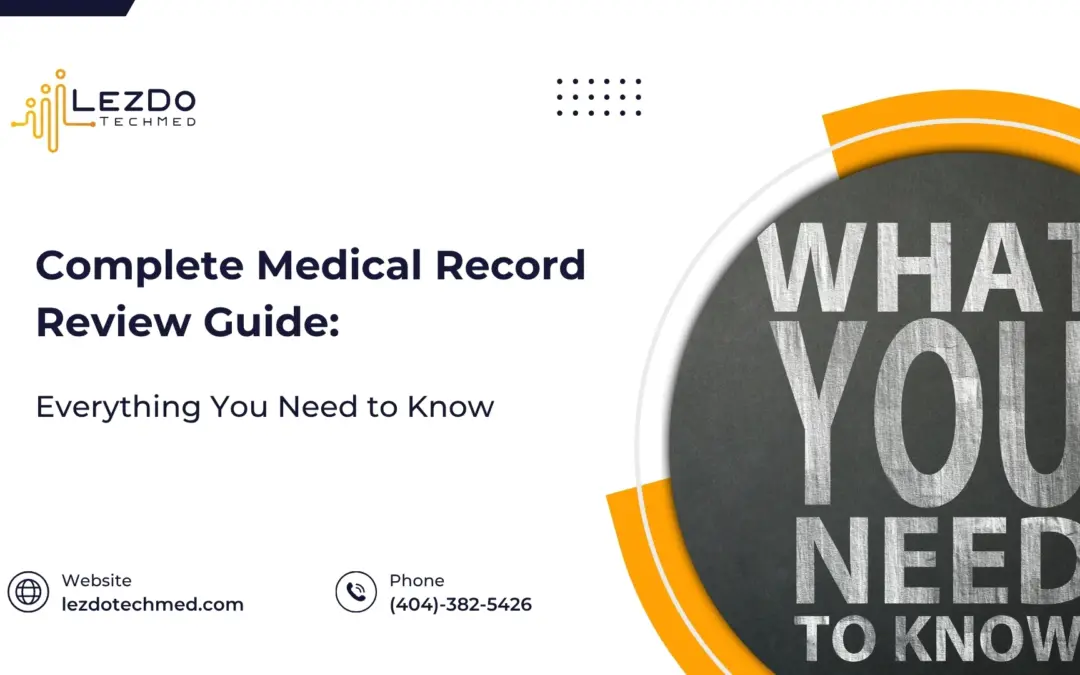Attorneys handling Social Security Disability cases will need strong medical evidence to support claims. This evidence is to be developed by reviewing medical records. Attorneys requesting medical record reviews for disability claims should therefore have a clear understanding of the medical records required in each case. This blog highlights some important tips attorneys can consider when preparing to review an individual’s medical records.
Before delving into the details, let’s first understand what Social Security Disability is and when one should apply for it.
What is Social Security Disability (SSD)?
Social Security Disability is a federal program designed to provide monetary assistance to people who are unable to work due to a determinable physical or mental impairment that is expected to last for more than a year or result in death. Through this, the eligible claimant can get financial stability and much-needed medical care.
Do People Need SSD? Why and When?
People need SSD when they are no longer able to engage in substantial gainful activity (SGA) due to their medical condition. SSD benefits cover living expenses, medical costs, and other essentials for those who are unable to work due to their disabilities. Applying for SSD requires thorough medical documentation to prove the severity and impact of the impairment on the person’s ability to work.
Usually, people go for SSD benefits when they:
- Are diagnosed with a serious medical condition that impairs their ability to work.
- Experienced a significant decline in their health that prevents him from going to work.
- Encounter long-term or permanent disabilities that restrain them from performing work-related tasks.
What is a medical review by Social Security for disability?
It is an assessment of medical documentation to determine if a claimant qualifies for benefits. Medical records for disability claim must include diagnostic reports, physician notes, and evidence of treatment. Medical record review for SSD claims is essential to provide the Social Security Administration (SSA) with comprehensive evidence of the claimant’s medical condition.
A medical review for Social Security disability ensures that the claimant’s impairment meets SSA’s strict eligibility criteria. The SSDI medical review process involves a detailed evaluation of the claimant’s medical records, diagnosis, and treatment history.
The frequency of disability reviews may vary; however, the SSA re-evaluates claims periodically based on the condition’s severity. The SSA has guidelines for how often SSA reviews disability cases, which usually occur every 3 to 7 years, depending on the condition.
How long does a medical review take for disability? It depends on the completeness and organization of the medical records.
Tips for Reviewing Medical Records in Social Security Disability Claims
Reviewing medical records in depth is a critical step to receiving benefits of SSD claims. The accuracy and thoroughness of this review can significantly influence the outcome of a claim. Here are some best tips to ensure an effective and efficient review process.
- Collect comprehensive evidence in medical charts
How to get medical records for disability? Contact all the facilities and providers with whom the individual consulted with regard to his ailments. Gather all the relevant medical records, including:
- Physician charts
- Diagnostic reports
- Imaging results such as X-ray, CT, and MRI reports
- Treatment plans and progress notes
- Surgical procedure notes
- Discharge summary
- Disability diagnosis
These medical documents can provide evidence of the claimant’s medical condition and how it impacted the claimant’s ability to work, making the medical review for disability hassle-free.
- Understand the medical condition
How important are medical records to your disability claim? It is essential to have a clear understanding of the claimant’s medical condition before reviewing medical records. Then, go through the symptoms, treatment plans, and prognosis. This background knowledge will help in assessing the adequacy of the medical evidence.
- Organize the records
Medical records can be voluminous and complex. Organizing them chronologically to create a clear timeline of medical events will help in understanding the progression of the claimant’s health issues and the impact on his ability to work.
- Focus on key medical evidence
Focus on key pieces of medical evidence that support the claimant’s disability, including diagnostic test results, treatment records, and physician notes. Pay special attention to the diagnosis to ensure there is a clear and consistent diagnosis documented by medical professionals. Look for detailed descriptions of symptoms, and how they limit the claimant’s ability to perform work-related activities. Review the types of treatments the claimant has received and their outcomes.
This information is crucial for the SSA to evaluate the limitations that prevent the individual from engaging in sustainable gainful activity (SGA- the maximum monthly income that can be earned by the claimant if not disabled).
- Look for consistency
Consistency in the medical records is crucial. Inconsistencies in different medical reports or between the claimant’s statements and the medical evidence can weaken the case. Ensure that the medical records consistently reflect the severity and impact of the claimant’s condition. This might involve obtaining clarification from medical providers or additional evidence to resolve discrepancies. Consistency in medical records adds credibility to the disability claim and supports the assertion that the impairment is ongoing and severe.
- Evidence for treatment compliance
The SSA considers whether the person has been actively seeking the prescribed medical treatment. Medical charts that demonstrate a history of treatment, medication adherence, and compliance with healthcare recommendations strengthen the claim for disability benefits.
- Verify compliance with SSA requirements
The Social Security Administration (SSA) has specific requirements for medical evidence in disability claims. Ensure that the medical records meet the requirements, like objective medical evidence in comprehensive medical records, which are up-to-date. The SSA places significant weight on objective medical evidence such as lab results and imaging studies.
- Highlight supporting medical opinions
Medical opinions from treating physicians, specialists, and other healthcare providers can be highly influential in getting disability benefits. Highlight any supporting opinions that support the claimant’s disability and inability to work. Make sure these opinions are well documented and backed by medical evidence.
- Support disability onset date
Accurate and detailed medical records help establish the onset of the disability, which is crucial for determining when the individual became unable to engage in substantial gainful activity due to their impairment.
- Utilize medical summaries
Creating medical record summaries can help condense and highlight the most important aspects of the medical records. Summaries can be useful for quickly referencing key information during the claims process and for presenting a clear picture of the claimant’s health condition to the SSA.
- Seek expert assistance
If the medical records are particularly complex or if you are unsure about any aspect of the medical evidence, seek assistance from medical experts specializing in SSD claims. Their expertise can provide valuable insights and strengthen the claim.
- Keep detailed notes
Throughout the SSD documents review process, keep detailed notes on important findings, inconsistencies, and any additional information needed. These notes can serve as a reference and help ensure that no critical details are overlooked.
To wrap up, reviewing medical records for SSD claims is a rigorous process that requires attention to detail, medical knowledge, and an understanding of SSA requirements. By following these best practices, you can improve the quality of your medical record reviews, ultimately improving the chances of a successful SSD claim. Thorough preparation and a systematic approach are essential to present a strong and convincing case to the SSA.
Reach out to LezDo TechMed for comprehensive medical record reviews for SSD claims.
Need Quality Medical Record Reviews?











